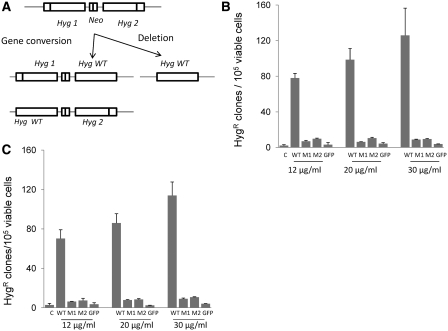Figure 2.
Effect of yRad52tat11 on intrachromosomal recombination. (A) HeLaG1 cells contain two copies of HygR genes inactivated by 10-bp insertions, either at a unique PvuI site (hyg1) or at a unique SacII site (hyg2); the two mutated hyg genes are in direct repeat orientation and are separated by a sequence containing the amino-glycoside phosphotransferase (Neo) gene conferring resistance to G418; an intrachromosomal recombination event occurring by gene conversion between the two hyg sequences results in restoration of one of the mutant hyg genes to wild type; the intrachromosomal deletion of the DNA sequence between the two mutated hyg genes leads to the formation of a HygR wild type (Hyg WT) with loss of intervening sequence; the intrachromosomal recombination was measured after incubating HeLaG1 cells with 12, 20 or 30 µg/ml yRad52tat11 proteins for 24 h (B) or 48 h (C). The frequency of intrachromosomal recombination was determined as total HygR clones per 105 viable cells; the data are reported as mean of three to five independent experiments ± standard deviation; GFPtat11 (12, 20 and 30 µg/ml) was used as negative control (C in B and C); WT, wild-type protein; M1 and M2, Y66A and R70A mutant proteins, respectively.

